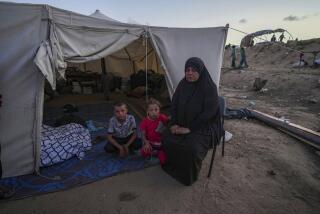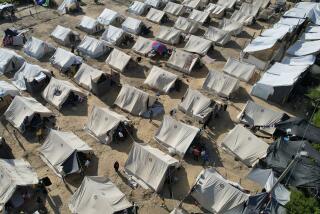Refugees Forming Bonds on Web
- Share via
DAHAISHA REFUGEE CAMP, West Bank — The e-mail has already started to pile up in the new computer center at this refugee warren on the outskirts of Bethlehem:
“My name is Itaf,” writes a 13-year-old Palestinian living in the Shatila refugee camp in Lebanon. “We are all waiting to go back to Palestine to see the village of our grandfathers. Please, tell me about Palestine. We don’t know about it so much here.”
In yet another use of Internet technology, a network of Web sites is being formed that will link up Palestinian refugee camps in the West Bank, Gaza Strip and, eventually, Lebanon, Syria and Jordan.
The goal is to provide a form of “virtual travel” that will cross the seemingly impenetrable borders of the hardscrabble camps in an effort to connect former neighbors, distant relatives and curious children.
With financial and technical assistance from Canada and the West Bank’s Birzeit University, the Web sites in Arabic and English are being put together by refugees and will include oral histories about each camp’s early days, online testimonies about life today and a full information bank aimed at encouraging activism and awareness.
“If you live in Dahaisha, your life is Dahaisha,” said Muna Muhaisen, a Palestinian American who lives in the Dahaisha camp and is one of the brains behind the Across Borders project. “Children in Dahaisha know nothing about children in Shatila.”
An estimated 1.2 million Palestinians live in 59 camps throughout the Mideast. (A similar number are registered as refugees but do not live in recognized camps.) They or their parents fled or were forced into exile by the creation of Israel 51 years ago.
Despite their shared history, there is little contact between refugees in different camps. To go from a camp in the West Bank to one in Gaza, for example, is only about 70 miles but requires Israeli travel permits that are often hard to get.
The Internet project comes at a time when new movement in the Arab-Israeli peace process does not seem likely to address the plight of the refugee.
“People are not happy about what is happening to them, but they need information,” Muhaisen, 39, said.
Muhaisen and her associates installed the first 14-computer center here at Dahaisha camp this month.
The camp’s Web site, which will be online in early August, opens with a black-and-white 1949 photo of the camp, when it was a collection of tents straddling the road to Hebron. The Web site has links to pages like “pen pals” and “martyrs.”
Across Border centers are to open in 10 more camps during the next two years.
Given the Web site’s potential as an outlet for venting political viewpoints and opposition, the project’s coordinators expect the ruling Palestinian Authority to be less than enthusiastic.
The most pressing obstacle, however, may come from Islamic conservatives who fear the openness that surfing the Web allows. Resistance to the Internet remains strong in some parts of the Arab Middle East.
The Dahaisha program is housed at the Ibdaa Children’s Cultural Center, a squat white building on the edge of a jagged road. Muhaisen said Ibdaa (Arabic for innovation) is one of the few youth centers that allows boys and girls to study together--and that, she said, was a prerequisite.
The local imam periodically berates parents for allowing their children to attend the coeducational center, Muhaisen said.
“We have to convince the parents, and it takes time, but I think we will overcome this problem,” said Fida Amin, 22, a chemistry graduate who was busy uploading onto the Dahaisha site an oral testimony from a fellow refugee recounting his years in an Israeli prison.
The Across Borders Web site is at https://www.acrossborders.org.
More to Read
Sign up for Essential California
The most important California stories and recommendations in your inbox every morning.
You may occasionally receive promotional content from the Los Angeles Times.











